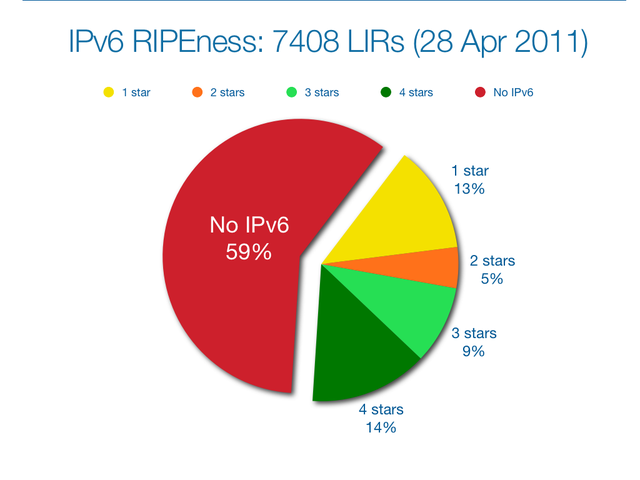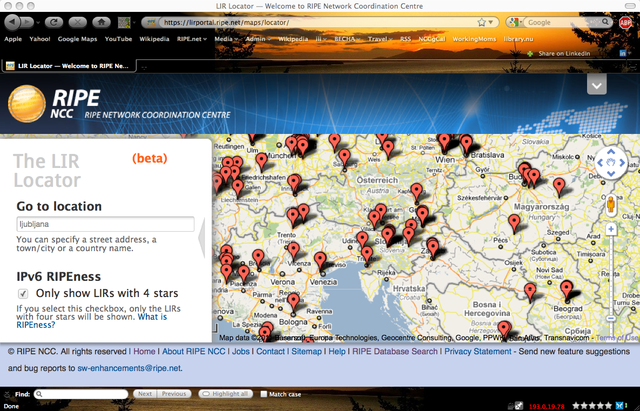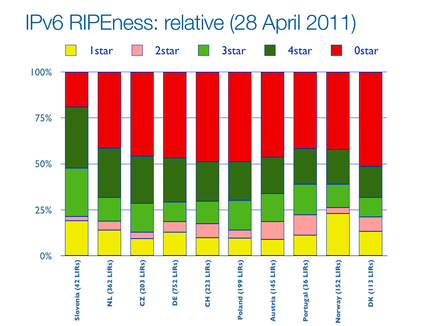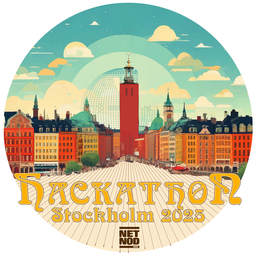A year ago we introduced IPv6 RIPEness - a system that rates IPv6 deployment of Local Internet Registries based on certain criteria. It was meant to encourage LIRs to deploy IPv6. Now, one year later, we are proud to present the progress of this project.
In the article IPv6 RIPEness - First Steps which was published a year ago, we introduced a system where the IPv6 deployment of Local Internet Registries (LIRs) are rated based on four criteria (or stars as they are called in the system).
In the image below, you can see the number of LIRs that have one to four stars and those that have no IPv6 at all in April 2011.

The Numbers
In April 2010, 27% of all 6,748 LIRs had IPv6 address space (that means one star). 8% of all LIRs (or a total of 540), had all 4 stars: IPv6 address space, a route6 object in Routing Registry, reverse DNS delegation, and their routed prefix was visible in the Routing Information Service (RIS ).
Now one year later the numbers are as follows: 41% of all LIRs has IPv6 address space, and 13% has all four stars. But, the absolute numbers are even more impressive: more then 3,000 LIRs have IPv6 address space - which means that the RIPE NCC has made more then 1,100 IPv6 allocations within 12 months!
We are now taking bets on the date when we will reach 50% of LIRs that have an IPv6 allocation. Some people think we will reach this number in January 2012, others are more optimistic and think we reach 50% just before RIPE 63 in October 2011.
What's your bet?
The 'Carrot'
The initial goal of the IPv6 RIPEness measurements was to determine where we need to provide more IPv6 training course and promote IPv6 more actively. However, it turned out to also fulfill other purposes and has become a popular measurement of IPv6 readiness.
IPv6 RIPEness has now also been included in the LIR Locator tool , which helps us to visualise on a map how much IPv6 there is in a certain country or region. We can now target LIRs in a specific region on the map as illustrated in Figure 2 below.

Figure 2: LIRs with 4-star IPv6 RIPEness in the LIR Locator
Furthermore, we added the IPv6 RIPEness information to the IPv6 training course material, as a graph in the slides -- but also as a present: before every course, we find out how many participating LIRs have a "four stars" status, and we bring them "IPv6 Act Now" T-shirts as a reward! They love it!
After each course, we receive several emails asking for T-shirts - from the LIRs that did their "homework" and achieved four-star status as part of their homework. We send T-shirts to these LIRs and receive many thankful emails.
The original plan was to only send T-shirts to the first 50 LIRs. But, by now, we must have shipped over 150 T-shirts, and the demand is still high!
The 'Stick'
Per country statistics turned out to be very useful. They often prompt governments and other organisations to encourage IPv6 deployment in their country and to compete with their neighbours.
We have been presenting these statistics at numerous conferences ( 2010 , 2011 ) throughout the RIPE NCC service region, and they were always received with great interest.
On Figure 3 below, you can see the percentage of 0 (red) to 4 (dark green) stars for Lirs in ten countries.

We have a dedicated web site for the IPv6 RIPEness statistics: http://ipv6ripeness.ripe.net . Here we present aggregated country statistics (pie charts) and the list of all "four star" LIRs that offer services in a specific country. This list is automatically generated and updated daily.
The goal of this listing is to promote the LIRs that are IPv6-ready, and to provide a shopping list for all those who are looking for IPv6-enabled LIRs. We also hope that it will encourage those LIRs who are not yet listed to deploy IPv6 at least to the level of "four stars".
Wish-list
We are constantly working to improve the IPv6 RIPEness project and to incorporate all the suggestions we received so far. Highest on the list of new features is adding a fifth (and/or sixth?) star based on the additional criteria : either reachability, or a combination of few criteria.
Good news is that in the meantime more criteria became available:
- the "pingable" attribute was implemented in the RIPE Routing Registry

- a policy for mandatory registration of customers' IPv6 assignments was approved
- RPKI resources certification service has started, and it is possible to generate ROAs for IPv6 address space
Additional "nice to have" features include:
- making it possible for LIRs to see their IPv6 RIPEness status in the LIR Portal (also if they have less than 4 stars)
- "historical view per country" daily statistics
- higher resolution pie-charts
- specific IPv6 RIPEness-specific t-shirts :)
- provide a gallery for t-shirt photos
- RIPEness rating for other regions
- IPv4 RIPEness
(In the foto on the right, taken by Alex Band, you see Marco Hogewoning, co-chair of the RIPE IPv6 working group wearing an IPv6ActNow t-shirt).
We are also looking for students who would like to take some of the features on as a study project. If you are interested, please let us know!
The future
IPv6 RIPEness is still only a prototype, and it is maintained on the best-effort basis by Emile Aben from the RIPE NCC Science Group. If this is viewed as a valuable service by the RIPE NCC members, we will make this into a production service. By leaving comments on this post, or your support on the "ncc-services-wg" mailing list , you can influence the decision of RIPE NCC to add more resources to this project and to give it higher priority.
Questions, summarised
- What are your predictions - when will we reach 50% of LIRs having IPv6?
- Do you wish us to implement any additional features to the IPv6 RIPEness?
- Are you a student, or do you have students, who can contribute to this project?
- Please express your support for IPv6 RIPEness becoming a production service





Comments 1
The comments section is closed for articles published more than a year ago. If you'd like to inform us of any issues, please contact us.
Anonymous •
I would like to express my support for IPv6 RIPEness becoming a production service.<br /><br />I would also like to see e-mails towards each LIR originating from the NCC and highlighting LIR's current RIPENESS score, and probably easy/quick suggestions for them to improve it!<br />